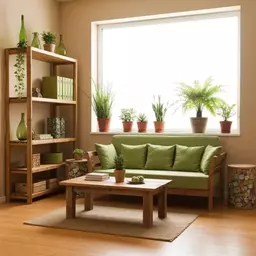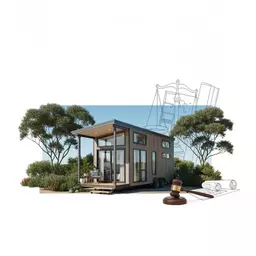Light Tones
Whites, pastel shades, and light grays illuminate the room while reflecting natural light.
Get expert advice, innovative design ideas, and practical tips for your tiny home journey in Australia.
Posted on: 2025-10-25
By: Sophie Marchant
Color can completely transform the atmosphere of your living space, especially in tiny homes where every detail matters. By thoughtfully choosing your color palette, you can create a cozy sanctuary that reflects your personality and promotes well-being.
Understanding how different color palettes can enhance the ambiance and functionality of tiny spaces is essential. Below is a visual representation of the recommended color schemes and their psychological impacts.
Whites, pastel shades, and light grays illuminate the room while reflecting natural light.
Soft yellows and earthy tones create a welcoming and cozy environment.
Perfect for bedrooms to foster tranquility.
Ideal for kitchens, promoting energy and freshness.
Strategic use of bold colors can add personality without overwhelming the space.
Grounding tones that add warmth and connection to nature.
Color plays a crucial role in how we experience our living space, especially in tiny homes where every inch counts. It can make a small area feel larger and more inviting or create an atmosphere that feels cramped and chaotic. As someone who embraces the tiny living movement, I’ve discovered that choosing the right colors can truly transform a compact area into a cozy sanctuary. For more insights on optimizing your living space, explore our guide on space-saving tiny house designs.
In tiny homes, color influences not only the visual perception of space but also our mood and functionality. For instance, soft, light colors can help open up space, while darker shades may make a room feel smaller. So, what colors are best for optimizing your tiny home? Let's explore some essentials!
When it comes to choosing colors for your tiny home, understanding color psychology is key! Colors can evoke feelings and influence how we perceive our surroundings. For example, blue is often seen as calming and can make a space feel serene, while green connects us to nature and promotes relaxation.
Light and neutral tones are particularly effective in small spaces. They have the power to create an airy feel, making rooms appear more spacious. By combining these tones with accents that reflect your personality, you can create a home that feels both open and uniquely yours!
As a passionate advocate for sustainable living, I believe that color choices should go hand-in-hand with eco-friendly materials. Fortunately, there are many brands that focus on producing sustainable paints, which are perfect for tiny homes. Selecting paints that are low in volatile organic compounds (VOCs) is crucial for improving indoor air quality. This aligns perfectly with the principles of sustainable living in tiny homes.
When shopping for eco-friendly paints, look for certifications like Green Seal or EcoLabel. These labels ensure that the products meet strict environmental standards. Here are some brands to consider:
Incorporating sustainable materials into your tiny home can significantly enhance both the aesthetics and environmental impact of your space. Materials like reclaimed wood, bamboo, and organic textiles not only add warmth but also contribute to a healthier planet. To learn more about material selection, check out our guide on selecting materials for tiny homes.
When selecting colors, consider how they interact with these sustainable materials. For example, warm browns from reclaimed wood can pair beautifully with earthy greens and soft whites. This harmonious blend not only looks great but also reflects a commitment to eco-friendly living!
One of the best ways to create an inviting atmosphere in your tiny home is by using colors that reflect the beauty of nature. Imagine bringing the lush greens of a forest or the warm browns of earth into your living space! Such colors can create a calming and grounding effect.
Consider incorporating hues that you might find in the great outdoors. For example, soothing greens can remind you of lush landscapes, while browns can evoke the warmth of a cozy cabin. Using natural pigments can also enhance this connection, ensuring your home feels like a true reflection of your values.
Here's a brief recap of the key points discussed so far:
Are you ready to transform your tiny home with eco-friendly colors? Painting can be a fun and rewarding DIY project! Follow these simple steps to make the process smooth and enjoyable.
With these steps, you’ll create a beautiful, sustainable environment that reflects your values. As the founder of The Tiny Living Guide, I love seeing the joy that comes from personalizing tiny spaces!
Have you ever thought about how the seasons can inspire your color choices? Adapting your palette can enhance your tiny home’s vibe throughout the year. Here are some tips to consider:
By varying your colors with the seasons, you can keep your tiny home feeling alive and connected to the world outside!
Using low-VOC and energy-efficient paints is a fantastic choice for tiny home enthusiasts! Here’s why these paints are worth considering:
As you embark on your tiny home journey, consider using these energy-efficient products. They are a simple way to make a positive impact on both your home and the environment!
When it comes to small spaces, light colors can create the illusion of more space. Some of my favorites include:
Using these colors can greatly enhance the comfort and spaciousness of your tiny home.
Eco-friendly paints often come with numerous benefits! Here’s how they stack up against traditional options:
Choosing eco-friendly paint isn’t just good for the planet—it’s also better for your well-being!
Color choices can significantly influence indoor air quality. To create a healthy environment, consider:
By consciously selecting colors and materials, you can support a healthier living environment in your tiny home.
It’s clear that color plays a crucial role in tiny home design. By prioritizing eco-friendly practices, you create a space that’s not only beautiful but also sustainable. Remember, every choice you make contributes to a healthier planet! If you're looking for more inspiration, explore various tiny house design ideas simplified to get started.
As you consider your next steps, I encourage you to explore eco-friendly brands and products. Dive into research on sustainable color options and materials that resonate with your values. Together, we can make a difference in the tiny home community!
Here is a quick recap of the important points discussed in the article:

 What if your small living space could also be a sanctuary for the planet? Embracing sustainability n
What if your small living space could also be a sanctuary for the planet? Embracing sustainability n
 As the tiny home movement gains momentum in Australia, the legal landscape can feel daunting. Howeve
As the tiny home movement gains momentum in Australia, the legal landscape can feel daunting. Howeve
 Did you know that zoning laws can significantly impact the feasibility of sustainable housing initia
Did you know that zoning laws can significantly impact the feasibility of sustainable housing initia